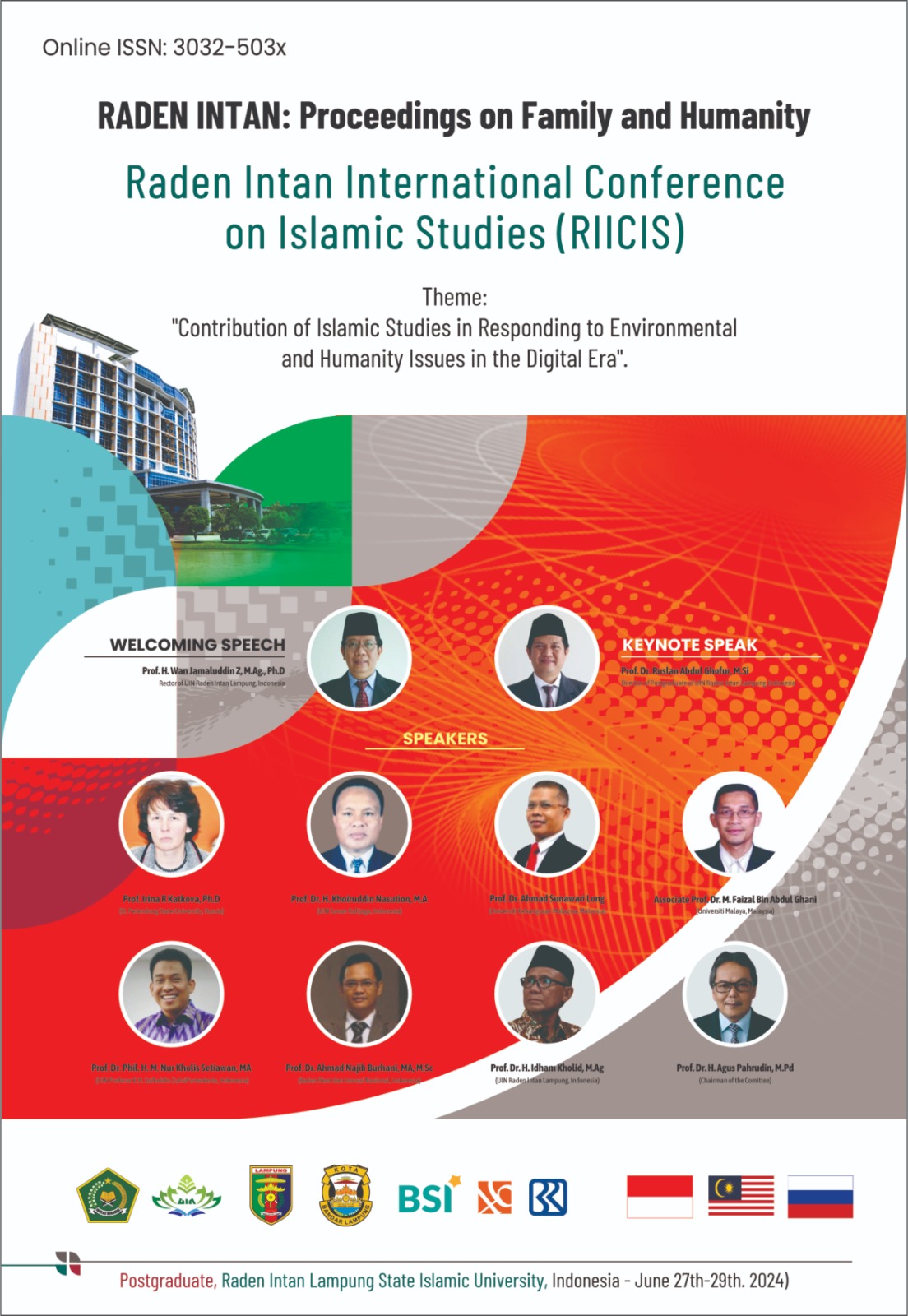Published 2025-01-01
Keywords
- Domestic Violence,
- Women,
- Islamic Law
Copyright (c) 2024 Abdul Qodir Zaelani, Dewani Romli (Author)

This work is licensed under a Creative Commons Attribution 4.0 International License.
Abstract
Islam is a religion that upholds the dignity of humanity, the birth of Islam to eliminate all forms of violence and slavery, one of which is domestic violence. However, in fact, domestic violence still occurs a lot, and domestic violence that is often the victim is women (wives). The purpose of this article is to reveal the implications of domestic violence against women, then analyze domestic violence from an Islamic perspective. This type of article is qualitative, this type of article is library research, the approach in this article is a normative approach, data sources are obtained from several literatures, both journals, books related to the study of domestic violence from an Islamic perspective. The results of the analysis show that the psychological implications of victims of domestic violence can experience "Dialectics of Trauma", namely symptoms of post-traumatic stress as follows, including Hyper Arousal, Intrusion, and Numbing. Nash's texts in Islamic law are not a basis and reason for committing violence against women and domestic violence. However, Islamic teachings and laws always understand the relationship between men and women as an equal relationship and must be fair. Although in general the victims are women, it remains a shared responsibility to address it. In addressing violence against women, domestic violence must use a cohesive approach that includes several aspects and involves all parties.
References
- Abu Daud, S. A. (n.d.). Kitab An-Nikah Bab Fi Dhoroub Al-Mar’ah, Hadist-2145 Juz II. Berub, Dar AL Fikri.
- Amalia, M. (2011). Kekerasan Perempuan dalam Perspektif Hukum dan Sosiokultural. Jurnal Wawasan Hukum, 25(02), 399–411.
- Asnawi., H. S. (2024). Mental Rehabilitation of Divorce Prohibition Victim Wives Throughthe Balancing Institution of Megou Pak Customary Pepung and its Implications Against Household Harmony. COUNS-EDU: The International Journal of Counseling and Education, 8(3). https://doi.org/10.23916/0020230842630
- Asnawi, H. S. (2012). Membongkar Patriarkhisme Islam Sebagai Kearifan Budaya Lokal: Sebuah Kritik Terhadap UU. No. 1 Tahun 1974 Tentang Perkawinan. ESENSIA: Jurnal Ilmu-Ilmu Ushuluddin, 13(2), 223. https://doi.org/10.14421/esensia.v13i2.739
- Asnawi, H. S. (2022). Hegemoni Patriarkhisme Hak Keadilan Perempuan dalam Undang-Undang Perkawinan di Indonesia. The Journal Publishing. http://thejournalish.com/ojs/index.php/books/article/view/358
- Al- Quran dan Terjemahannya; Kemeneterian Agama RI. (2020). Solo.
- Asnawi, H. S. (2024). Sejarah, Urgensi dan Tipologi Pencatatan Perkawinan dalam Undang-undang Keluarga Islam di Negara Muslim. Bulletin of Community Engagement, 4(2). https://attractivejournal.com/index.php/bce/article/view/1468
- Baqih, I. M. (n.d.). Kitab An-Nikah Dar Al- Mar’ah Haidst 1985, Juz I. Berut; Dar Al Fikir, tt : Hadist-2146, Lij Juga;.
- Bayu Wicaksono, A., & Son Ashari, W. (2024). Analisis Perlindungan Islam Terhadap Perempuan Korban Kekerasan dalam Rumah Tangga dalam Tinjauan Maqashid Syariah. Rayah Al-Islam, 8(3), 888–904. https://doi.org/10.37274/rais.v8i3.1027
- DKK, H. S. (2002). Panduan Pengembangan Pusat Krisis Berbasis Masyarakat. Jakarta: Kemenetrian Pemberdayaan Perempuan RI.
- Elli Nur Hayati, W. H. (2002). Buku Panduan Pelatihan Penghapusan Kekerasan Terhadap Perempuan) Untuk Tingkat Lapangan. Jakarta: Kementerian Pemberdayaan Perempuan RI.
- Fakih, M. (2012). Analisis Gender & Transformasi Sosial. Yogyakarta: Pen Pustaka Belajar, Cek ke IVX.
- Firdawaty, L., Asnawi, H. S., & Mahmudah, S. (2024). Semanda Lekok in the Sai Batin Community, Lampung: Wife’s Domination of Marital Assets from Maqāṣid al-Sharī’ah Perspective. Samarah, 8(3). https://doi.org/10.22373/sjhk.v8i3.19894
- Fauzie Ridjal, L. M. (1993). Dinamika Gerakan Perempuan di Indonesia. Yogyakarta: PT Tiara Wacana.
- Habib Shulton A, Fatul Mu’in, M. A. N. (2020). Hak Perempuan Disabilitas dalam UU. No. 1 Tahun 1974 Tentang Perkawinan: Perspektif Convention On The Rights Of Persons With Disabilities (CRPD). Yurisprudentia: Jurnal Hukum Ekonomi, 6(2). http://194.31.53.129/index.php/yurisprudentia/article/view/3098
- Ismail. (2020). Discrimination against wife in the perspective of CEDAW and Islam Mubādalah. Ijtihad: Jurnal Wacana Hukum Islam Dan Kemanusiaan, 20(2), 253–268. https://doi.org/10.18326/ijtihad.v20i2.253-268
- Idjnir, A. A. (1969). The Qur’an Women and Modern Sosiaty,Terjemahan Agus Nuryanto, Pembebasan Perempuan . Yogykarta: lkis.
- Jassos, A. (n.d.). Ahkam Al-Quran (TTP: Dal Al Fiker, lt) I:374-375.
- Luhulima, A. S. (2014). CEDAW Menegakkan Hak Asasi Perempuan (Yayasan Pustaka Obor Indonesia). Jakarta.
- Muhajarah, K. (2017). KEKERASAN TERHADAP PEREMPUAN DALAM RUMAH TANGGA: Perspektif Sosio-Budaya, Hukum, dan Agama. Sawwa: Jurnal Studi Gender, 11(2), 127. https://doi.org/10.21580/sa.v11i2.1452
- Musdah, S. M. ( 2004). Muslimah Reformis Perempuan Pembaru Keagamaan. Bandung: Mizzan.
- Nassarudin Umar dan Amani Lubis, H. S., & (Ed), R. G. ( 2002). Mutiara Terpendam Perempuan Dalam Literatur Islam Klasik. Jakarta: Gramedia.
- Sabiq, S. (1990). Fikih Sunnah Jilid 7 dan 8. Bandung: PT Alamarif .

